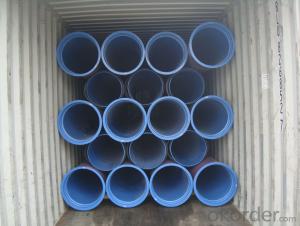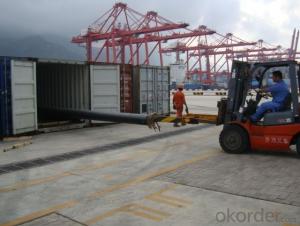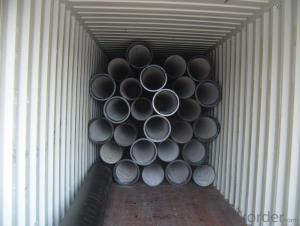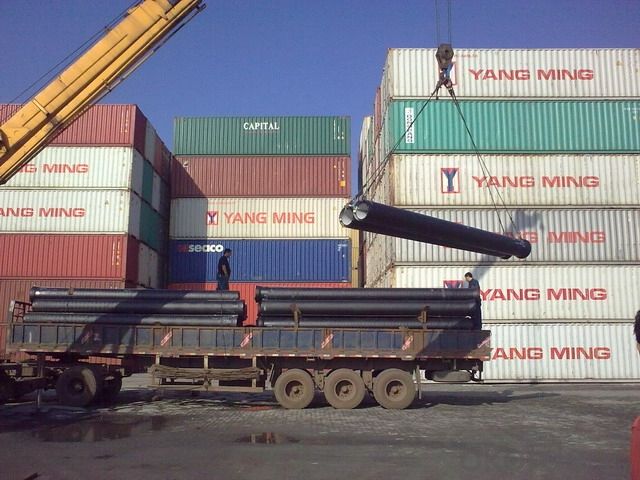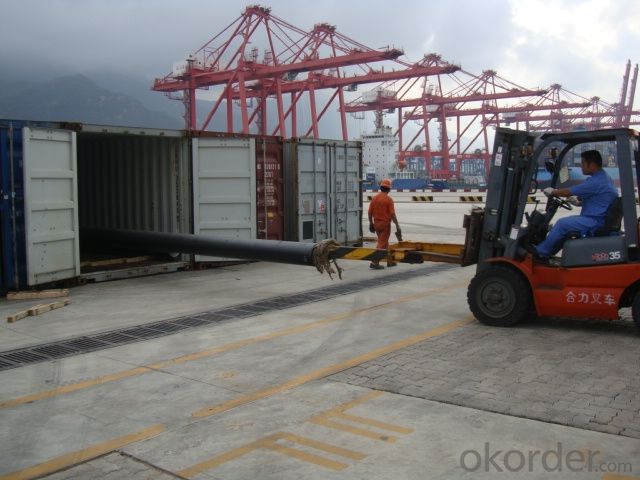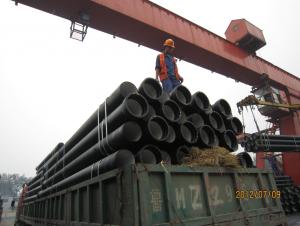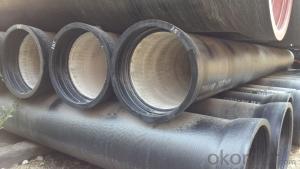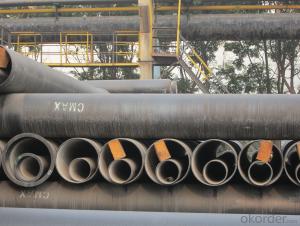Ductile Iron Pipe DN900
OKorder Service Pledge
Quality Product, Order Online Tracking, Timely Delivery
OKorder Financial Service
Credit Rating, Credit Services, Credit Purchasing
You Might Also Like
Specifications
Quick Details
| Place of Origin: | China (Mainland) | Brand Name: | CMAX | Model Number: | T type / K type / Flange type |
| Length: | 6m / 5.7m / Negotiable | Standard: | ISO2531 / EN545 / EN598 | Application: | Potable / Sewage water |
| Diameter: | DN80~DN2200 | Shape: | Round | Hardness: | 230 |
| Pipe Wall Thickness: | standard | Pull Strength: | 420 | Yield (≥ MPa): | 300 |
| Material: | Ductile Iron | Type: | Centrifugal ductile cast iron pipe | Certification: | ISO2531 / EN545 / EN598 |
| Outer Diameter: | 80-2200 | Thickness: | standard | Specification: | DN80~DN2200 |
| |
The advantages to the customer:
Trustworthy financial strength.
One-stop shopping.
Fast and efficient service.
Coordination of shipments from multiple plants.
Specialists of the overseas shipping process.
A more competitive price.
- Q: Are ductile iron pipes suitable for installation in areas with high groundwater salinity?
- Yes, ductile iron pipes are generally suitable for installation in areas with high groundwater salinity. Ductile iron is known for its corrosion resistance, making it a preferred choice in such environments. However, it is crucial to consider the specific salinity levels and consult with experts to ensure proper pipe coating and protection measures are in place to prevent any potential corrosion or degradation.
- Q: Are ductile iron pipes resistant to UV degradation?
- No, ductile iron pipes are not resistant to UV degradation.
- Q: What are the specifications for the installation of water ball iron pipes?
- Ductile cast iron pipe is characterized by mild, high, thin wall, pressure resistance, impact resistance, corrosion resistance, seismic resistance and other properties. The flexible interface is used for the pipeline interface, and there is a certain elongation and deflection angle. The utility model has the advantages of the raw iron pipe and the steel pipe material, and avoids the defects of iron and steel.
- Q: What does ductile iron pipe "K" mean?
- The higher the K level, the better the quality, and the national standard requires K9
- Q: What is ductile iron?
- Ductile iron is a type of cast iron that has been treated with magnesium or cerium to improve its mechanical properties. It is called "ductile" because it has a higher degree of ductility compared to other types of cast iron. Ductility refers to the ability of a material to be stretched or deformed without breaking. This characteristic makes ductile iron highly suitable for applications that require high strength and resistance to wear and tear, such as pipes, automotive components, and machinery parts. The addition of magnesium or cerium to the iron during the manufacturing process helps to form graphite in the structure, which gives ductile iron its unique properties. This graphite formation also helps to make the iron more flexible and less brittle, enabling it to absorb shock and vibration without fracturing. Overall, ductile iron offers a balance between the strength of cast iron and the flexibility of steel, making it a versatile material for various industrial applications.
- Q: How can the steel plastic composite pipe be connected with the cast iron pipe?
- Use stainless steel clamps to connect.
- Q: How can the three pipes of ductile iron leak?
- The raw material used in RE can be installed in the thread, can also be used on the same thread AB, re install is also available, but it is hard to remove.
- Q: Can ductile iron pipes be used for irrigation of golf courses?
- Certainly, ductile iron pipes are applicable for the irrigation of golf courses. Renowned for their durability, strength, and resistance to corrosion, these pipes are suitable for a wide range of uses, including irrigation systems. They possess the ability to endure high-pressure water flow and are less prone to cracking or breaking when compared to alternative materials. Moreover, ductile iron pipes boast an extended lifespan, minimizing the necessity for frequent maintenance or replacement. Consequently, they represent a dependable option for the irrigation of golf courses, where a continuous and efficient water supply is imperative for sustaining healthy turf and landscaping.
- Q: Are ductile iron pipes resistant to frost heave?
- Yes, ductile iron pipes are generally resistant to frost heave due to their strong and flexible nature.
- Q: Can ductile iron pipes be used for irrigation systems in agricultural fields?
- Yes, ductile iron pipes can be used for irrigation systems in agricultural fields. Ductile iron is known for its durability, corrosion resistance, and ability to withstand high pressure, making it suitable for transporting water in agricultural irrigation systems.
Send your message to us
Ductile Iron Pipe DN900
OKorder Service Pledge
Quality Product, Order Online Tracking, Timely Delivery
OKorder Financial Service
Credit Rating, Credit Services, Credit Purchasing
Similar products
Hot products
Hot Searches
Related keywords

